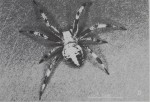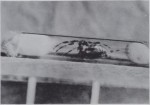Warning: Trying to access array offset on value of type null in /home/elisew5/public_html/drpeterwitt.com/wp-content/plugins/contextual-related-posts/includes/content.php on line 49
View this article in Search Friendly Plain Text
NOTE: This plain text article interpretation has been digitally created by OCR software to estimate the article text, to help both users and search engines find relevant article content. To read the actual article text, view or download the PDF above.
Reprinted from American Zoologist Vol. 9, No. 4, November, 1969
10
PETER N. WITT, CHARLES F. REED, and MABEL B. SCARBORO, N. C. Department of Mental Health Differences in web-patterns between tube- and cage- raised spiders ( Araneudiadematus Cl.).
Petrusewiczowa (1938) and Mayer (1953) raised young orb-weavers in narrow glass tubes, thereby preventing construction of webs for three weeks. After the animals were released, the intricate geometric structure of the first webs seemed to indicate that no previous construction experience was required for the “normal” adult web. However, experiments like those of LeGuelte (1969) and Reed et al. (1969) suggested that web-construction is modified by experience. In the present experiment a group of tube-raised spiders was matched by a control group in age and weight; webs were tested statistically in 27 expressions dealing with size, regularity, and shape. Whether release took place after 35 or 94 days of confinement, the first webs were significantly different from controls in several features, while the webs built one week later hardly differed at all. Some of the difference in size could be eliminated if thread was emptied from the glands of the tube spiders twice in two days before release, pointing to a possible slow-down of silk production in the tube-spiders’ glands. However, web-irregularity—which persisted after emptying the glands of tube-raised spiders—seems to require an assumption that early web-construction has an influence on later web-building. Feeding-experiments in which the fly was given directly into the grasp of the spider rather than being entangled in the web, showed significantly less web-construction by hand-fed spiders, indicating a possible reinforcing effect in the use of the web as a trap. (Supported in part by NSF Grant GB-6246X1.)



